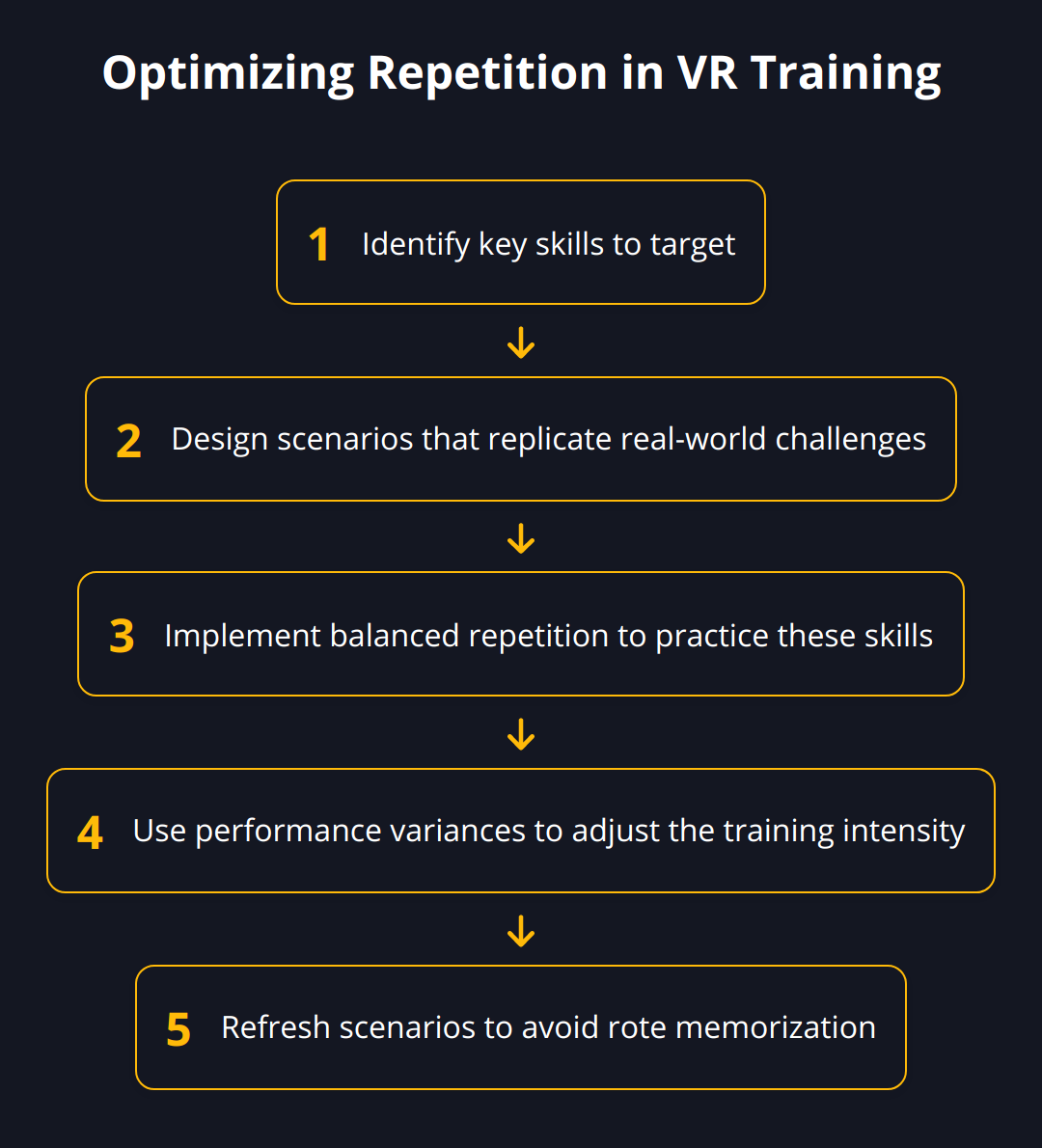At Newroom Connect, we understand the transformative power of Virtual Reality (VR) in professional training. With the right approach, VR can revolutionize the way knowledge is absorbed and retained.
In this post, we’ll share proven tips for maximizing the impact of VR in training sessions, enhancing learning retention, integrating VR into corporate learning, and maintaining VR training systems. These insights aim to guide you to not just implement but excel with VR training in your organization.
Enhance Your VR Training
Harnessing the potential of virtual reality (VR) training is more than just a technological feat; it’s an investment in your workforce’s competence and confidence. To elevate your training sessions, meticulously crafting scenarios that closely resemble real-world challenges enables your team to translate virtual experiences to practical skills. It’s an unwavering commitment to relevance that sets the stage for impactful learning.

When designing VR training, immersion is the gateway to engagement, yet it must be deftly balanced with interactive elements that reinforce learning objectives. Delivering an experience that captivates the senses while invoking critical thinking and decision-making echoes the complexity of actual tasks employees face daily.
Inclusivity in training design isn’t just fair practice; it’s savvy strategy. It ensures everyone, regardless of background or learning style, can benefit from the VR environment. Adopting diverse avatars, offering adjustable settings for different needs, and removing language barriers with multilingual support are steps toward embracing a wider audience.

Make every second count in VR training environments by considering these targeted strategies:
-
Align virtual scenarios with the real operational landscape.
-
Craft immersive content that demands interaction, but doesn’t overwhelm.
-
Focus on inclusive design to improve access and comfort for all learners.
For instance, involving key stakeholders such as front-line managers in the scripting phase has led to training modules that reflect true-to-life situations, increasing the applicability of the learned skills. Industry data suggests that when trainees perceive direct relevance to their roles, retention rates soar.
On the technology side, investing in high-quality VR headsets plays a vital role. Comfort and ease of use encourage longer, more focused training sessions, directly tying to better outcomes.
Equally vital is a systematic approach to ensure your VR content stays current. It’s not a ‘set and forget’ scenario. Regularly revising and updating your VR training program in line with evolving business needs and feedback will keep the momentum of learning. Data-driven revisions underscored by actual user feedback support continuous improvement, fostering a culture of learning that evolves alongside your organization.
The ensuing chapter will continue this journey, exploring the implementation of VR into corporate learning systems, ensuring that the experience learner journey remains as revolutionary as the technology itself.
Boosting VR Learning Retention
Elevating retention rates in VR training is imperative for translating virtual experiences into real-world proficiencies. Let’s examine how weaving narratives, reinforcing through repetition, and leveraging performance analytics can turn VR training into a stronghold of skill acquisition and knowledge retention.
Weave Engaging Narratives

The essence of an unforgettable VR training experience lies in crafting compelling narratives. Storytelling isn’t simply about entertainment; it’s a strategic tool for engagement — one that makes complex information more digestible and memorable. To harness this, each training module should tell a story where learners can see themselves as the protagonists, facing and overcoming challenges that mirror their workplace realities. This technique fosters an emotional connection that helps solidify memory retention.
Consider healthcare training VR modules that place medical professionals into high-stakes emergency scenarios. By navigating through the narrative — making critical decisions and dealing with the consequences — trainees embody the learning material, ensuring that lessons stick.
Reinforce Through Repetition and Practice

Practice makes permanent, especially in VR where the muscle memory from repeated actions in a simulated environment can directly translate to the physical world. Implementing modules that require repeated, deliberate practice boosts confidence and competence. For instance, incorporating drills that simulate emergency protocols allows firefighters to react intuitively during actual emergencies. The key is balanced repetition — enough to build proficiency without causing burnout or disengagement.
Performance variances after each session can guide the cadence of repetition, ensuring that learners are neither underchallenged nor overwhelmed. A study shows that mixing up the scenarios also helps by preventing rote memorization and promoting adaptive learning.
Harness Feedback for Continuous Improvement
Immediate, constructive feedback in VR training is a game changer for learning retention. It provides learners an insight into their performance — what’s working, what’s not — enabling real-time adjustments. Beyond subjective assessment, integrating analytics tools to track performance offers actionable data. Tracking metrics like completion time, decision-making patterns, and error rates reveals invaluable insights. Continuous feedback loops can clarify personal strengths and areas for improvement, making the learning process dynamic and responsive.
For maximum effect, trainers should consider:
-
Integrating real-time analytics for immediate feedback
-
Providing personalized post-session debriefs
-
Facilitating peer-to-peer feedback within the VR space
These strategies ensure training is a constructive loop, rather than a one-time event.
Remember, another chapter follows this one, continuing to unpack the intricacies of effectively integrating VR into corporate learning ecosystems. The journey to truly effective VR training strategies is ongoing, as we aim to take the capabilities of VR technology and match them to the beating heart of human learning — connection, repetition, and growth.
VR Training Integration
Integrating Virtual Reality (VR) into corporate learning programs is not just about staying on top of tech trends—it’s a strategic move to align workforce development with the business’s heart: its goals and objectives. Successfully bridging the gap between exciting VR opportunities and concrete business outcomes leads to an empowered and skilled workforce, driving tangible competitive advantages and financial performance.
A laser-focused alignment of VR training efforts with specific business goals is essential. Start by identifying the skills and competencies that directly contribute to your organization’s success. Are you looking to reduce equipment-related incidents? Then tailor your VR training to simulate operational environments that test and reinforce proper handling procedures. The closer the training reflects actual job requirements, the stronger its impact on performance and, ultimately, on breaking new grounds in efficiency and innovation.

While VR training stands out for its immersive qualities, it isn’t a standalone solution. Blending it with traditional training methods creates a robust learning ecosystem. For example, follow-up group discussions or hands-on practice can ground virtual experiences in reality. This blended approach smooths out the learning curve, appeals to various learning styles, and reinforces VR training’s experiential learning.
No initiative worth its salt escapes the scrutinizing eye of measurement. Measuring training outcomes and Return on Investment (ROI) for VR initiatives is vital and, thankfully, highly scientific. Consider using quantitative metrics such as reduced training time, error rates, and cost savings alongside qualitative measures like user satisfaction and confidence levels. Keeping a finger on the pulse of training effectiveness means making adjustments that resonate with the end goal—workforce supremacy in an ever-changing market landscape.
To sum it up, here are actionable insights for seamless VR integration into your corporate learning:
-
Sync VR training scenarios with company-specific challenges and opportunities.
-
Enhance VR learning with conventional methods for a comprehensive approach.
-
Set quantifiable targets to track training impact and demonstrate ROI.
A case in point is the efficacy seen in companies like Walmart, which applied VR training to prepare employees for Black Friday crowds, resulting in improved customer service and operational efficiency. A reported reduction in training time and increased employee confidence underline the potential that lies in astutely applied VR training strategies.
Leaving the door ajar for even further progress, we move toward covering how to maintain and support VR training systems. Next, we’ll explore the practical steps necessary for sustaining an effective VR training environment over time, without ever losing sight of the end goal: empowering your workforce and solidifying your market position.
Sustaining VR Training Systems
To establish a thriving VR training program, meticulous attention to the maintenance and upgrading of systems is mandatory. Like any sophisticated technology, VR demands a proactive stance in upkeep to ensure its effective utilization and long-term viability. Keeping systems modern and functional translates to uninterrupted training experiences and, ultimately, superior learning outcomes.
Stay Current with Hardware and Software
In the realm of VR, obsolescence is not an option. Continuously monitoring and updating VR hardware and software is pivotal for delivering seamless training operations. This practice significantly extends the lifespan and functionality of your VR setup. Key elements include:
-
Regularly updating VR software to patch security vulnerabilities and enhance features.
-
Upgrading hardware components such as headsets, sensors, and input devices to avoid compatibility issues.
-
Performing preventive maintenance to reduce the risk of hardware failure during critical training sessions.
For instance, the steady stream of software updates ensures compatibility with the latest VR headsets, which can drastically improve resolution and tracking accuracy, leading to more engaging and effective training experiences.
Arm Your Team with Knowledge
Empower facilitators and IT staff to handle the technical demands of VR training by investing in their continuous professional development. Adequate training in troubleshooting and system management equips them to resolve potential issues swiftly, minimizing downtime.
Consider these practical steps:
-
Offer detailed hands-on training for facilitators to familiarize them with the latest VR technology and software interfaces.
-
Set up regular workshops for IT staff on advanced troubleshooting and system optimization.
A well-informed team is capable of not only maintaining the systems but also improving the overall learner experience by leveraging the full capacities of VR technology.
Keep Abreast of VR Training Developments
Advancements in VR technology are relentless, with new applications and functionalities emerging frequently. Remaining apprised of the latest developments in VR training is not just advantageous; it’s essential for staying competitive.
Implementing novel VR training methods can enhance learning engagement and effectiveness. This may involve integrating haptic feedback for a more tactile experience or incorporating advanced data analytics for personalized learning pathways.
Here are some actionable ways to stay informed:
-
Subscribe to industry publications for the latest news on VR trends and applications.
-
Attend VR conferences and workshops to network with industry experts and gather fresh insights.
-
Participate in online forums and social media groups where practitioners share knowledge and experiences.
In the rapidly evolving landscape of VR, being up-to-date means your program will always be relevant and impactful, harnessing the exhilarating potential of VR technology to improve training scenarios and learning retention. Remember, as we distill these insights into our practices, we set the stage for the next conversation on enhancing user engagement within VR learning environments. Keep an eye out for that insightful discussion!
Final Thoughts
Virtual reality training represents a significant shift in how we approach upskilling and empowering our workforce. As we’ve explored throughout this piece, the advantages of VR in professional development are clear: immersive learning environments lead to higher retention rates, reduced training times, and a workforce robustly prepared for real-world challenges. The effectiveness of VR training is not just a promise; it’s an evidenced outcome, reflecting an impressive convergence of technology and educational insight.
![Key Takeaways - Virtual Reality Training [Pro Tips]](https://newroom-connect.com/wp-content/uploads/2023/12/Virtual-Reality-Training-Pro-Tips-6-2023-12-26-071209.6843950000.png)
Adopting VR within an organization’s training regime requires a certain boldness—a commitment to evolve and continually seek improvement in one’s developmental strategies. We at Newroom Connect take pride in providing platforms where such boldness can translate into reality, crafting virtual spaces like trade fairs and showrooms that embody the same innovative spirit found in VR training.
Here are key takeaways from our dive into VR training:
-
VR training stands out in efficiency and its capacity for profound learning experiences.
-
Adoption benefits are massive, ranging from heightened employee readiness to cost savings.
-
Continued development of VR programs ensures that companies stay ahead of the curve.
As we reflect on the thoroughness and innovation VR training adds to the professional development landscape, we encourage organizations at every scale to consider how this dynamic tool can fit within their training portfolios. The continual journey towards enhanced training solutions is well underway, and VR is leading the charge with each stride. True to the spirit of Newroom Connect, embracing VR in training is about seizing the tools our era offers to construct a more knowledgeable, skilled, and adaptable workforce.
To further explore how VR and other virtual experiences can redefine your company’s learning and development landscape, venture over to Newroom Connect. Together, let’s elevate our sights to future possibilities where innovation meets the practical needs of dynamic and effective training.


